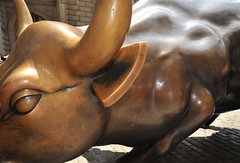| Bull Itch (Photo credit: emilio labrador) |
Boston, Jul.5, top stocks .- Though painful, the recent sell-off in bonds has had three positive effects on the bond market:
First, it reinforced the fact that the bond market's movements are mechanical and predictable.
Second, it drove up rates on all bonds to more reasonable levels.
And third, it demonstrated, yet again, that some bonds hold their value even in sell-offs.
Mechanical Movement
If you push on one end of the bond market, the other end always has, and always will, go up. The Fed has been pushing like crazy to drive interest rates down, so prices had to go up - way up.
This is a unique quality that only bonds offer. In no other investment is there a more predictable cause and effect relationship. That predictability gives bond buyers an advantage.
And the Fed isn't finished pushing yet. The current administration has bet everything on stimulus and it won't let go of the idea until at least after the 2014 election.
Before then, Washington will continue the money printing, which is keeping rates down, because the big spike in rates that will result will very likely cause another recession. That could cost the Democrats control of the Senate.
Expect the money printing to continue for a while and rates, specifically the 10-year Treasury, to move back to the 2.2% to 2.0% level.
Rising Yields
The recent selling caused the prices of most bonds and bond mutual funds to fall, but being the mechanical beasts they are, their yields, of course, went up.
That's good news for income investors. We are still below normal payout levels, but the market is becoming more attractive than last spring.
The average corporate bond yield is back above the 6% level, which has always been considered the floor for corporate yields. The average had been as low as 5%.
As rates make their slow, inevitable climb back to more reasonable levels, most bond prices will continue to drop, and yields will continue to move back up. But most analysts think it could be four to five years before we see more normal rates.
This brings us to the best part of the bond market.
Stable Values
The most valuable aspect of the predictable nature of bonds is that the shorter the maturity of a bond, the less it drops in value in a sell-off.
Except in rare instances, this is cast in stone and gives bond holders a level of security and reliability unmatched by other investments.
This is a huge advantage for bond holders because despite the fact that bonds pay their coupon rate no matter what the market price does, people still get jittery in sell-offs and do dumb things like sell into a panic.
The predictable and stable nature of short-maturity bonds is usually enough to prevent them from panic selling, which is how you lose money, not make it.
In the recent sell-off, as always, bonds with maturities of less than six to seven years saw a small fraction of the drop in market value that longer maturity bonds and bond funds experienced. During the heaviest part of the selling, the bonds I manage saw price drops of 0.5% to 2%. Some bonds actually went up in price.
And no matter how much bonds drop in market value, they still pay their interest every six months and return $1,000 at maturity. That's security! Enough security to keep most investors in their holdings, where they are making money.
A Good Example
Here's a bond that has a short maturity, a big annual return and, because of its short maturity, will hold up well under future market pressure.
Yes, it will lose a bit of value as rates continue their inevitable rise. But, with an annual return of around 11% a year, income of over 8%, and the fact that most of the world can't make electricity without their product, it looks like a pretty good bet.
Arch Coal: This bond (CUSIP 039380ae0) is priced at about 84.5 (that's $845 per bond), has a coupon of 7% and matures in June of 2019.
That means:
-
Its maturity is within the market price stability zone of seven years; minimal price fluctuation. - It will return an 18.45% capital gain at maturity ($1,000 minus our cost).
- It will pay $70 per year per bond in interest no matter what the market price does. Which means it has a current yield of 8.28% (7% divided by our cost of $840).
- And once the White House eases up on the war on coal, its price could run up considerably long before maturity for a big short-term gain.
Keep your maturities inside the safety zone of seven years, and you can earn above-average returns and still get the most stable ride in the business.
.


No comments:
Post a Comment